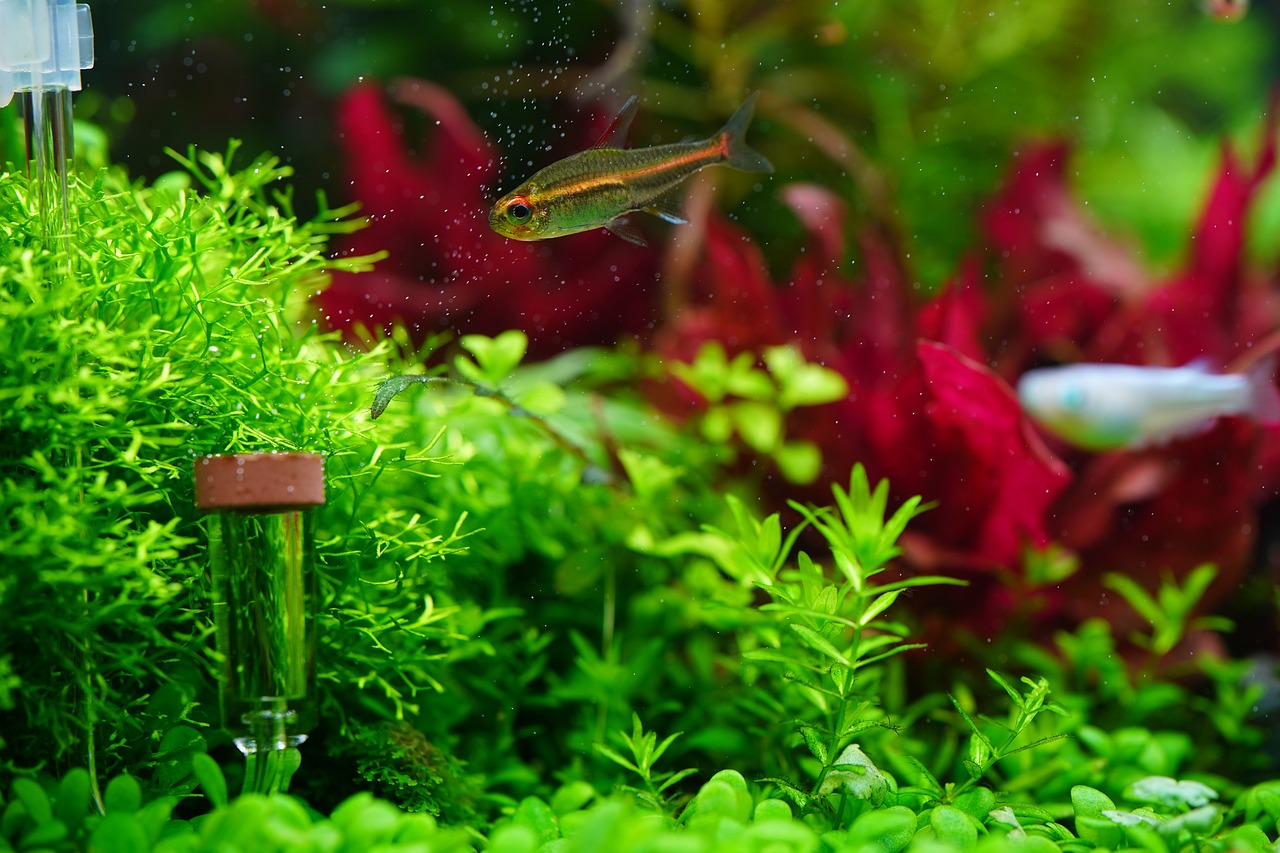Nutrient deficiency symptoms in aquatic plants
Growth laws
1855 Liebig's minimum law
The growth factor at the minimum is solely responsible for the yield!
Strictly speaking, this no longer applies today, because although an increase in the minimum factor leads to the greatest increase in growth, the influence of the other nutrients is not taken into account.
Mayer (1869) extended the minimum law to all productive factors, which for aquaristics means taking lighting, temperature, pH, growth density etc. into account.
Liebscher (1895) and Wollny (1877) recognised that an increase in yield by increasing a productive factor is only possible up to a certain maximum value, beyond which a drop in yield occurs again. Furthermore, the more the other factors are at the optimum, the greater the effect of the growth factor at the minimum on yield.
→ Optimum law
In 1945, Voisin also pointed out the yield-reducing effect of an excess of a nutrient.
→ Law of the maximum


Individual deficiency symptoms
When diagnosing plant damage, please note that many of these observations can only be made in the laboratory by specifically omitting one and only one nutrient.In practice, combinations of different deficiencies are much more likely.
Similarly, apparent deficiency symptoms can be induced by over-fertilising with one protagonist, as many plant uptake systems are responsible for several nutrients.
This is one of the reasons why single-nutrient fertilisation is often not very effective, especially if you do not take into account the mutual dependencies in nutrient uptake (e.g. potassium ↔ magnesium).
In the presence of certain water parameters (e.g. GH > 1, Ca deficiency not possible) or the use of certain preparations (e .g.Ferrdrakon, in the presence of a sufficient iron content there can be no manganese or boron deficiency), some of the deficiencies that initially appear possible from the table are ruled out from the outset.
One of the main observations is often a more or less pronounced chlorosis, which can be further specified depending on how it occurs on leaf surfaces and veins. In addition, stunted growth and slow or no growth at all are common.
Typical damage symptoms of chlorosis and further information...
Feeding damage
This must be differentiated from leaf damage caused by trace element deficiency.
Typical damage symptoms of feeding damage and further information...
Nitrogen
has a prominent position among the plant nutrients, as it is an essential component of chlorophyll, amino acids and peptides and other important compounds such as phytohormones.
The whole plant is only yellow-green in colour, with the older leaves being more affected than the younger ones. But even the older leaves do not die as long as the nutrient deficiency does not become extreme.
The plants can also turn purple in colour due to the increased production of anthocyanin.
Phosphorus (or phosphate)
There is no more growth. However, the whole plant remains green, sometimes even turning quite dark green.
Some species can turn purple due to anthocyanin production. Other species do not produce anthocyanin and simply remain green and small.
Calcium
First observed in meristematic tissues. Microscopically, there is a disintegration of the membranes and the breakdown of the compartmentalisation of the cells with subsequent autolysis and finally the disintegration of the tissue.
Slight deficiency: New leaves are smaller and twisted. The leaf tissue is reduced, but the leaf veins remain intact. The leaves are often curved.
Moderate def iciency: Frequent severe curvature or twisting of the leaves, which are greatly reduced in size. The new growth has white stripes or edges. The roots are stubby and twisted, and the root tips can die off.
Vallisneria leaves are heavily crumpled, as if they have tried to grow and have been squeezed into a very small space.
Severe defect: the new growth is almost completely white, the leaves tiny deformed stumps. The growing tip of both the shoots and the roots die off.
Magnesium
In dicotyledonous plants, the older leaves turn yellow from the edge inwards. The large leaf veins usually remain green, while the leaf edges turn yellow or whitish and die off.
Magnesium deficiency has not yet been observed or diagnosed in monocotyledonous plants such as Vallisneria, but the damage should include the death of the older leaves.
The plants may also turn purple in colour due to the increased production of anthocyanin.
Potassium
Small dead zones form in older leaves. They may start like small pinholes and then grow. In some species, such as horn ferns, the older leaves remain green while the dead areas increase in size. New leaves are reduced in size and leaf area. In other species, the older leaves first turn yellow before they die, but unlike magnesium deficiency, the leaf veins also turn yellow.
Potassium deficiency leads to clear, microscopically visible structural changes in the mitochondria (including cell organelles).
Increased respiration and a sharp drop in the P/O quotient (as an expression of the efficiency of ATP synthesis) show that respiration and energy transfer are decoupled.
Potassium is also involved in the biosynthesis of proteins and carbohydrates. In case of deficiency, low-molecular compounds accumulate in the cell.
It activates many enzymes, with the membrane-bound ATPases playing a key role.
Sulphur
Looks practically the same as nitrogen deficiency, but is rare, as sulphates are the predominant anions in many types of water alongside hydrogen carbonates.
Sulphur is not contained in chlorophyll, so sulphur deficiency chlorosis must be due to the impairment of protein biosynthesis caused by a lack of sulphur-containing amino acids.
Iron
Less chlorophyll is formed in the new growth. Leaves and stems have the same colour. The growing tips of hornwort first turn purple and then white, "Egeria densa" tips first turn yellow-green, then yellow with narrow leaves that "cling" tightly to the stem.
If the deficiency is slight, the new leaves of the sword plants are smaller with spots or broad stripes in the longitudinal direction, which are paler than the rest of the leaf.
In the case of severe deficiency, many plants completely lack chlorophyll during new growth and the affected plants therefore die quickly.
Manganese
Is very similar to iron deficiency, but the leaf veins remain green, while the tissue between the veins turns yellow and dies.
Copper
Leaf edges turn white and the leaf tips die off. Fertilisation of the fruit does not take place.
Zinc
Yellowish spots form between the leaf veins, starting at the leaf edges and tips. New leaves remain smaller.
Boron
Boron deficiency is very similar to calcium deficiency. The new growth is twisted and smaller. The growth tips of both the shoot and the roots die off.
If the deficiency is slight, the leaves of Cryptocorynes are curved and the roots are shortened and twisted.
Molybdenum
Older and middle leaves are blue-green in colour. Later, chlorosis occurs in the form of yellow spots between the leaf veins, then brown zones form along the leaf edges. Flowering is prevented.
Mobile ↔ Immobile nutrients
Once absorbed by the plant, nutrients are able to move through the tissue in different ways. More mobile elements can be transported from older parts of the plant to the growth centres; nutrient deficiency symptoms for these substances are first visible in the older parts of the plant. More highly immobilised elements can only reach the zones of strongest growth to a limited extent or not at all; visible deficiencies are first noticed in the new growth.
| Mobile elements | Immobile elements |
| N, P, K, Zn, Mo, (Mn) | Ca, S, Fe, B, (Mn) |
Sources of information
The specific descriptions of possible plant damage can be found at "The Krib", detailed descriptions of the cell biological causes of the visible damage can also be found at Amberger.

